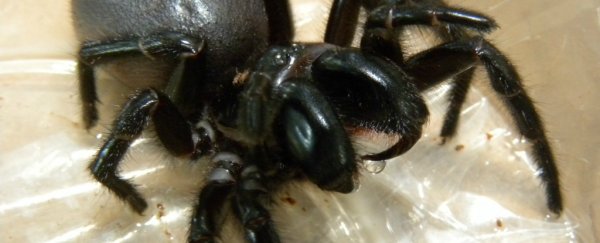Australian zookeepers are urging the public to gather up deadly spiders - including the infamous Australian funnel-webs - and bring them to designated drop-off points throughout the area, instead of killing them.
While asking the public to capture potentially fatal spiders seems odd, it's for a good reason: the zoo needs more spiders to make anti-venom, so bite victims can recieve the proper treatment.
"It's funnel web season but instead of killing them, we need the public to catch them so they can be a part of our venom-milking program," officials at the Australian Reptile Park in New South Wales said in a Facebook post.
The zoo, which is currently the sole supplier of funnel-web anti-venom, is lacking enough spiders to keep producing the much-needed antidote, because there were not enough donations last year.
"The Australian Reptile Park is the only zoo in Australia committed to saving lives with a venom-milking program in place for the past 50 plus years, saving over 300 lives each year being the sole supplier of a variety of venoms, which is used for all snake and funnel-web anti-venom in Australia," the zoo explains on its site.
Australian funnel-webs are a family of 35 different species in the subfamily Atracinae.
These spiders are extremely venomous to humans, with envenomation symptoms kicking in roughly 28 minutes after a bite. Symptoms include goose bumps, sweating, uncontrollable muscle twitching, and progressively increasing hypotension, which can lead to death.
The good news is that despite two recent reports of people being bitten in Australia, no one has died from a funnel-web spider bite since the anti-venom programs began in 1981.
But due to the lack of donations last year, the Australian Reptile Park has now reached out to the general public to bring them the spiders they need.
"We rely on community support to keep this program alive," the park's general manager, Tim Faulkner, told Claudia Farhart at Reuters. "We have tried to catch enough spiders ourselves, and we just can't."
To help, Faulkner put together a short video to demonstrate how a person should go about capturing the deadly critters.
He says the best course of action is to find a glass jar with a lid - plastic containers from your takeout meals will not work, because the spider's long fangs can pierce straight through them.
Before you capture the spider, add some substrate inside for the spider to sit on, such as damp dirt or camp cotton balls. Next, grab a stick or a ruler.
Once you've gathered your various spider catching paraphernalia, Faulkner says the best way to get capture the spider is to hold the jar behind the spider and gently coax the animal inside using the stick.
He notes that while the spider is extremely venomous, they do not jump, so coming close to them (but not too close) doesn't put you at a greater risk. Still, never risk picking the spider up or handling them.
After you've successfully captured the spider, you can drop it off at various locations, and park staff to pick it up, take it back to the lab, and start the milking process. Just make sure you don't leave the spider's jar in reach of children or direct sunlight.
Once milked at the park, the venom will be sent to another lab run by the vaccine maker CSL, which creates the actual anti-venom.
"With an appropriate jar and a wooden spoon, you can flick the spider into the jar so easily," Faulkner concluded to Reuters. "We've been doing this for 35 years and no one's been hurt."
So, if you live in funnel-web territory, get your jars ready, because zookeepers are counting on you.
Check out the video below to see Faulkner explain the capture steps with a real spider:
